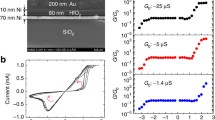Abstract
A novel systematic design of associative memory networks is addressed in this paper, by incorporating both the biological small-world effect and the recently acclaimed memristor into the conventional Hopfield neural network. More specifically, the original fully connected Hopfield network is diluted by considering the small-world effect, based on a preferential connection removal criteria, i.e., weight salience priority. The generated sparse network exhibits comparable performance in associative memory but with much less connections. Furthermore, a hardware implementation scheme of the small-world Hopfield network is proposed using the experimental threshold adaptive memristor (TEAM) synaptic-based circuits. Finally, performance of the proposed network is validated by illustrative examples of digit recognition.








Similar content being viewed by others
References
Driessche PVD, Zou X (1998) Global attractivity in delayed Hopfield neural network models. SIAM J Appl Math 58(6):1878–1890
Sporns O, Honey CJ (2006) Small worlds inside big brains. Proc Natl Acad Sci 103:19219–19220
Humphries MD, Gurney K, Prescott TJ (2006) The brainstem reticular formation is a small-world, not scale-free, network. Proc R Soc B Biol Sci 273(1585):503–511
Watts DJ, Strogatz SH (1998) Collective dynamics of ‘small world’ networks. Nature 393:440–442
Bassett DS, Bullmore ED (2006) Small-world brain networks. Neuroscientist 12:512–523
Hu X, Feng G, Li H, Chen Y, Duan S (2014) An adjustable memristor model and its application in small-world neural networks. In: 2014 international joint conference on neural networks (IJCNN). Beijing, China
Fekete T, Beacher FDCC, Cha J, Rubin D, Mujica-Parodi LR (2014) Small-world network properties inprefrontal cortex correlate with predictors of psychopathology risk in young children: a NIRS study. Neuroimage 85:345–353
Taylor NR (2013) Small world network strategies for studying protein structures and binding. Comput Struct Biotechnol J 5(6):1–7
Tkačik G, Marre O, Mora T et al (2013) The simplest maximum entropy model for collective behavior in a neural network. J Stat Mech Theory Exp 2013(03):P03011
Chua LO (1971) Memristors: the missing circuit element. IEEE Trans Circuit Theory 18(5):507–519
Strukov DB, Snider GS, Stewart DR, Williams RS (2008) The missing memristor found. Nature 453:80–83
Williams RS (2008) How we found the missing memristor. IEEE Spectr 45:28–35
Shin S, Kim K, Kang S-M (2013) Resistive computing: memristors enabled signal multiplication. IEEE Trans Circuits Syst I 60(5):1241–1249
Hu X, Chen G, Duan S, Geng G (2014) A memristor-based chaotic system with boundary conditions. In: Adamatzky A, Chua LO (eds) Memristor networks. International Publishing, New York, pp 351–364
Cong J, Xiao B (2011) mrFPGA: A novel FPGA architecture with memristor-based reconfiguration. In: Proc. IEEE/ACM Int. Symp. Nanoscale Architectures, 1–8
Mouttet B (2009) Proposal for memristors in signal processing. In: Proc. 3rd Int. ICST Conf., NanoNet 2008, Boston, MA. Revised Selected Papers, 11–13
Duan S, Hu X, Wang L, Li C, Mazumder P (2012) Memristor-based RRAM with applications. Sci China Inf Sci. 55(6):1446–1460
Thomas A (2013) Memristor-based neural networks. J Phys D Appl Phys 46(9):093001
Pickett MD, Strukov DB, Borghetti JL, Yang JJ, Snider GS, Stewart DR, Williams RS (2009) Switching dynamics in titanium dioxide memristive devices. J Appl Phys 106(7):074508
Abdalla H, Pickett MD (2011) SPICE modeling of memristors. In: Circuits and Systems (ISCAS), IEEE International Symposium on, pp. 1832–1835
Wang X, Chen Y, Xi H, Li H, Dimitrov D et al (2009) Spintronic memristor through spin-torque-induced magnetization motion. Elec Device Lett IEEE 30:294–297
Strukov DB, Williams RS (2009) Exponential ionic drift: fast switching and low volatility of thin-film memristors. Appl Phys A Mater Sci Proc 94(3):515–519
Corinto F, Alon A, Marco G (2012) Mathematical models and circuit implementations of memristive systems. In: Cellular Nanoscale Networks and Their Applications (CNNA), 2012 13th International Workshop on, IEEE, pp. 1–6
Pino RE, Bohl JW, McDonald N et al. (2012) Compact method for modeling and simulation of memristor devices: ion conductor chalcogenide-based memristor devices. In: Nanoscale Architectures (NANOARCH), 2010 IEEE/ACM International Symposium on, 1–4
Kvatinsky Shahar, Friedman Eby G, Kolodny Avinoam, Weiser Uri C (2013) TEAM: thrEshold adaptive memristor model. Circuits Syst I Regular Papers IEEE Trans 60(1):211–221
Ascoli A, Corinto F, Senger V, Tetzlaff R (2013) Memristor model comparison. IEEE Trans Circuit Syst 89–105
Biolek Z, Biolek D, Biolková V (2009) SPICE model of memristor with nonlinear dopant drift. Radio Eng 18:210–214
Rojas R (1996) Neural Networks. Springer, Berlin
Haykin S (1999) Neural networks: a comprehensive foundation. Prentice Hall, Englewood Cliffs
Liu B, Chen Y, Wysocki B et al (2012) The circuit realization of a neuromorphic computing system with memristor-based synapse design Neural Information Processing. Springer, Berlin Heidelberg, pp 357–365
Chartier S, Proulx R (2005) NDRAM: nonlinear dynamic recurrent associative memory for learning bipolar and nonbipolar correlated patterns. IEEE Transactions on Neural Network 16:6
Acknowledgments
The work was supported by Program for New Century Excellent Talents in University (Grant Nos.[2013]47), National Natural Science Foundation of China (Grant Nos. 61372139, 61101233, 60972155), ‘Spring Sunshine Plan’ Research Project of Ministry of Education of China (Grant No. z2011148), Technology Foundation for Selected Overseas Chinese Scholars, Ministry of Personnel in China (Grant No. 2012-186), University Excellent Talents Supporting Foundations in of Chongqing (Grant No. 2011-65), University Key Teacher Supporting Foundations of Chongqing (Grant No. 2011-65), Fundamental Research Funds for the Central Universities (Grant Nos. XDJK2014A009, XDJK2013B011).
Author information
Authors and Affiliations
Corresponding author
Rights and permissions
About this article
Cite this article
Duan, S., Dong, Z., Hu, X. et al. Small-world Hopfield neural networks with weight salience priority and memristor synapses for digit recognition. Neural Comput & Applic 27, 837–844 (2016). https://doi.org/10.1007/s00521-015-1899-7
Received:
Accepted:
Published:
Issue Date:
DOI: https://doi.org/10.1007/s00521-015-1899-7




